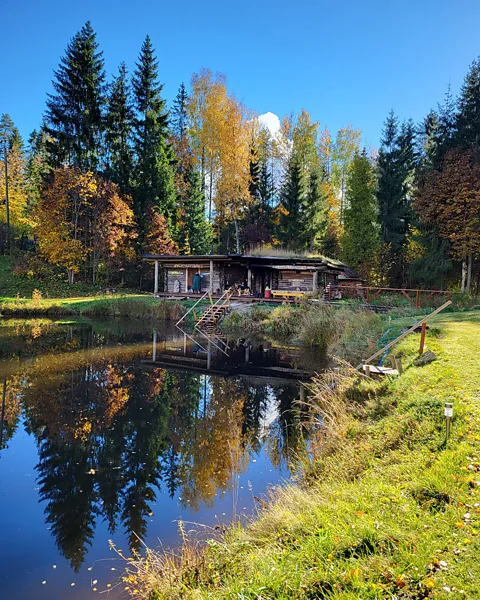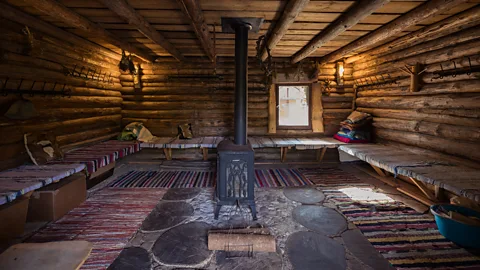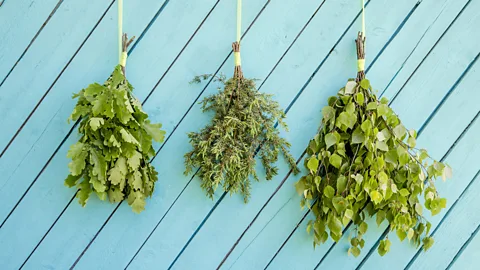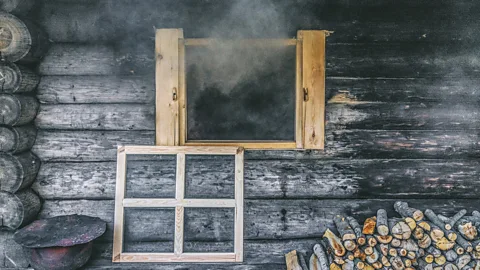Estonia's naked wellness tradition to cleanse both body and soul
 T Tuul
T TuulUsed for centuries by rural Estonians to heal their aches and pains, smoke saunas are a soulful experience that clears the mind and cleanses the spirit.
It's an uncommonly sunny March afternoon in Estonia but I'm in the dark cocoon of a smoke sauna, lying on a bench, completely naked. My feet are propped up on a sooty wooden beam and my head rests on a viht. This small bundle of thin oak branches is meant for lashing my bare body to slough off dead skin cells and boost circulation, but for the moment, it's a pillow. The dried leaves are pliant, though, after being soaked in water. Their earthy smell and the tang of smoke fill my nostrils. The air is damp, and beads of sweat cover my body.
Eda Veeroja, the owner of Mooska Smoke Sauna, is also naked. She drizzles water onto hot rocks piled on top of the brick stove. "Olen tuul üle väljade… Sind hoian, hoian endas [I am the wind across the fields… I hold you, I hold you]" she sings, the tune like a lullaby, the words hanging in the air like leil, the steam rising off the rocks.
Mooska is located in the south-eastern corner of Estonia, about 20km from the Russian border as the crow flies. It is part of Vana Võromaa, or Old Võromaa, which encompasses present-day Võru and Polva counties plus parts of Tartu and Valga counties. This remote region of rolling hills is the ancestral home of Võro, a Finno-Ugric language similar to Estonian with approximately 70,000 native speakers.
Veeroja has spent the past eight hours preparing the sauna. During the six-hour heating process, she fed logs to the stove inside the steam room. As a smoke sauna has no chimney, the steam room filled with smoke, the hot air rising to the ceiling, leaving just enough clear air below to allow her to continue stoking the fire. Once the interior temperature climbed over 80C, she opened a small hatch in the ceiling, ventilating the sauna for two hours before we went in.
 Veeroja
VeerojaSaunas, in one form or another, have existed in northern Europe for millennia. Ancient dwellings in Estonia were small chimney-less structures with a stove in the corner, meaning homes could be used as saunas or vice versa. A dig in the 1980s in northern Estonia provided what seems to be the first archaeological evidence of a purpose-built, stand-alone sauna, dating from between the 12th and 13th Centuries – likely predating the first written mention of the Estonian word "saun" in 1241.
From the Northern Crusades onward, Germanic culture overtook local commerce and religion, and Baltic Germans comprised most of the landed gentry in Estonia, even though control of Estonian territory passed from the Danes to the Swedes and eventually to the Russian Empire. During the Middle Ages, masons built "smokeless stoves" (stoves with chimneys) for wealthy townsfolk and some urban bathhouses.
However, local Estonian culture – including sauna culture – was sealed in a time capsule for 700 years, according to the 2023 book Sauna: History, Culture, Health and Construction – especially in South Estonia, which was far from Hanseatic towns and trade routes. Peasant life saw little improvement for centuries, and saunas in South Estonia continued to be built mostly chimneyless until the 1920s.
Following the end of Estonia's occupation by the Soviet Union in 1991, Veeroja travelled around Estonia and Europe. She soon realised that sauna practices had changed due to increased urbanisation and the advent of electric heaters. However, she saw that Võromaa's smoke saunas still had preserved something soulful that the others had long since lost, and she came to realise she had something special to share right in her own backyard.
Starting in 2009, Veeroja led the initiative to get Võromaa's smoke sauna tradition listed by Unesco, and in 2014, it was added to the list of Intangible Cultural Heritage. The listing includes the smoke sauna building; its construction and repair; and related customs such as smoking meat in the sauna, rituals related to celebrations and healing and making viht.
 Silver Gutmann
Silver GutmannSmoke saunas even made their international film debut last year with the release of Smoke Sauna Sisterhood, directed by Anna Hints. A native of Võru, the capital of Võru County, Hints spent seven years documenting the experiences of a group of women as they visited numerous smoke saunas around South Estonia, including Mooska. In the film, the smoke sauna is like a confessional. The women open up. They laugh and cry, sing and hold space in the silence. The smoke sauna becomes an additional character – the "cosmic womb", as Hints calls it – that is there to hold and heal.
After almost nine years in Estonia, I've been to more saunas than I can count, though never to a smoke sauna. I wasn't worried about the heat or the nudity. Even the idea of a cold plunge in between sweating sessions was exhilarating. It was this "soul" of the smoke sauna that made me feel a bit nervous.
When I spoke to Hints over video to prepare for my visit to Mooska, she explained how going to the sauna, especially the smoke sauna, can be a spiritual practice.
"[It] has always been therapeutic… with the heat, the physical dirt starts to come up from the deeper layers to the surface and then the emotional dirt starts to come up… You have the heat to sweat it out. You have the water to wash it away," Hints said. "Granny always used to say that in the smoke sauna, you wash not just your body, but you also wash your soul."
At Mooska, I scrub my body with ash, sweat and then rinse myself off in a pond half covered in ice. Then back to the sauna, where I slather myself with honey, lash my entire body from the soles of my feet to my neck, with the viht and again dunk myself in the pond. Back in the sauna once more, I lay on my stomach for Veeroja to take the viht to my back.
 Getty Images
Getty ImagesBetween sweating sessions, I relax in the cosy break room in front of a wood-burning stove. In what can only be described as half history lesson, half guided meditation, Veeroja talks about Võromaa's smoke sauna traditions while I sip hot tea and cold maple sap harvested from the trees tapped outside. As I have not once glanced at my phone, I have lost all sense of time.
More like this:
• The 10,000-year-old origins of the sauna
In the past, Estonians would not have called sauna-going a mindfulness practice, though certainly it was a chance to relax and socialise after a week filled with physical labour. Nor did the peasant population of South Estonia have access to the physicians who treated their wealthy landlords and the manor folk, so they turned to the sauna to heal their aches and pains.
Nowadays, most people visit the doctor when sick, yet Veeroja, like Hints, believes the sauna can be used to treat the spiritual ails of modern society. Studies have shown the physical benefits of heat therapy, including improved circulation and immune response, but the sauna experience at Mooska centres around the mental benefits.
Visitors to Mooska will not be beaten with a goose wing if they're cross-eyed, nor will ferns be used to break evil curses, even though these customs were once common practice. Yet the ritual of greeting and thanking the sauna remains. The point is to give sauna-goers the space to slow down. For example, scrubbing with ash is excellent exfoliation, but it also connects the mind to bodily sensations. "People who have been never in sauna before, but who do regular spiritual practices, like yoga or meditation, then they feel at home in the sauna," said Veeroja. "If somebody finds comfort and likes what we do in a smoke sauna, then [smoke sauna] can spread as wide as yoga culture."
 Tõnu Runnel
Tõnu RunnelWith the cultural cache provided by Unesco and the popularity of Hints' film, Estonians are returning to their roots and using the smoke sauna to slow down and reconnect with family and nature while recognising the economic upsides of preserving this ancient culture.
In his teens, 36-year-old Anti Konsap spent two years living in a sauna with his older brother while his parents worked to finish building their house. Despite recalling those years as lonely and dark, Konsap never lost his love for saunas. Even during his military service, weekly saunas provided much-need stress relief, as they would have to farm workers in the past. Last year, he salvaged the walls of a smoke sauna slated for demolition and hired a builder to reconstruct the sauna in a copse of birch trees south of Võru. The smoke sauna is a passion project, one he hopes he can eventually share with travellers to Estonia.
I asked Konsap if owning a smoke sauna makes him feel more connected to the past. He says yes, it does, adding, "I'm not too religious myself, but I think the sauna is a good place where you can talk to the spirits. You think about the old times and the grandparents and the people who all lived before you. It's a place to connect with old, old souls."
In the darkness of the sauna at Mooska, I don't talk to the spirits. I don't believe in them, and if I did, they would be back in the US, where I'm from, not here in Estonia. But I am here in Estonia. Veeroja chants softly in English, "You are whole; you are enough." I don't know if I am healed of all that ails me, but I do feel whole and wonderfully present in my body and in this place. And that is enough.
BBC Travel's Well World is a global take on wellness that explores different ways that cultures the world over strive for a healthy lifestyle.
--
If you liked this story, sign up for The Essential List newsletter – a handpicked selection of features, videos and can't-miss news, delivered to your inbox twice a week.
